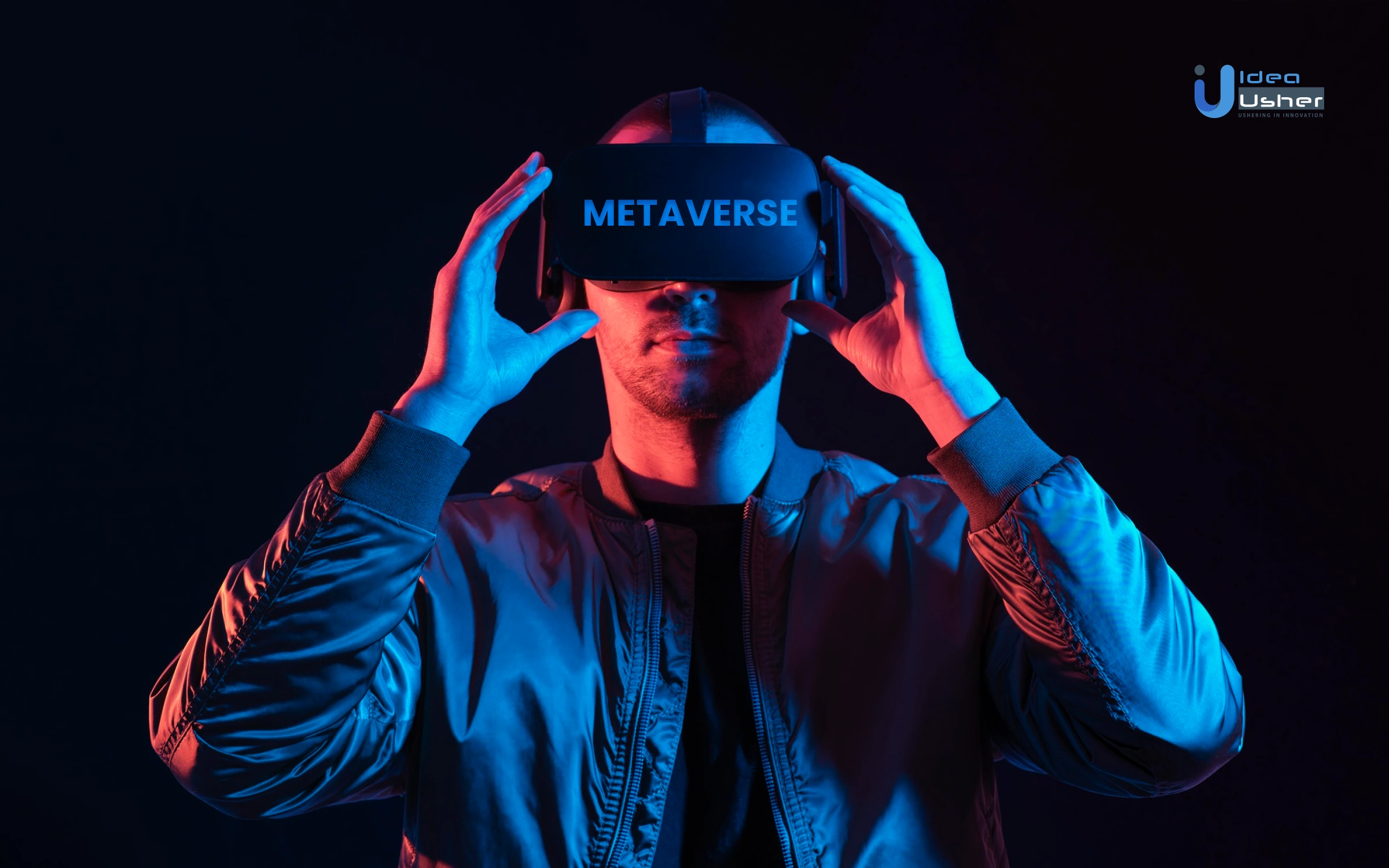
Metaverse is a three-dimensional universe, a technology that aspires to be the next generation of the internet. The experts predict that people will soon spend their entire day in the digital space as developers focus more on increasing the functionality and realism of the virtual world. In 2023, Metaverse is among technologies that promise to meet practically every real-world need in the virtual world, including socializing, shopping, trading, etc. But the question is, what are the trends evolving at the speed of light in the Metaverse in 2023, creating an opportunity for investment and return?

Top Metaverse trends to follow in 2023
1. Metaverse as a marketing channel
As technology continues to evolve, so do the opportunities for businesses to connect with consumers. Marketing and advertising, like search engines and social media, will catalyze the widespread adoption of web 3.0. Companies like JP Morgan, HSBC, Nike, and Gucci have already established their presence in this virtual world. Unlike search engines and social media, which are dominated by a few significant players like Meta and Google, the metaverse is still a relatively untapped market.
The allure of the metaverse lies in its potential for personalized and immersive customer experiences. In the coming year, businesses will compete to secure prime virtual real estate by creating their own platforms or utilizing existing ones such as Horizons, Fortnite, Decentraland, etc. Nobody is yet confident of the winning tactic, but one thing is sure: you must be involved to succeed.
For example, Metaverse introduces ‘Gamevertising,’ which includes advertising in games. It provides the virtual world with a medium to push ads to customers.
- Businesses can utilize in-game ads that appear within the game, such as billboards or avatars wearing branded clothing.
- There is a provision for sponsored content where businesses can sponsor items or events within the game.
- Businesses can create their branded virtual world for customers to interact in an immersive way. Businesses can also partner with Meta-influencers for promotions in the form of influencer marketing.
2. Corporate Metaverse
The metaverse is more than just a powerful marketing tool, and it has the potential to revolutionize the way we conduct business. The Metaverse promises to offer virtual environments, platforms, and tools where work may be done remotely, conveniently, and effectively.
One among many ways the metaverse is being utilized is by creating “digital twins.” The idea of the “digital twin” and the metaverse concept are likely to converge in the future, which may be used to test and develop new ideas in the secure realm of the internet. From products like Formula 1 cars to wind farms, designers are recreating physical objects inside virtual worlds where their efficiency can be stress-tested under any conceivable condition to save the resource and costs associated with testing products in the real world.
Additionally, Metaverse technology can also be used in the corporate world for onboarding, training, and other similar tasks. For instance, Accenture developed The Nth Floor, which includes virtual offices that are exact duplicates of actual ones and allows for the execution of many HR-related tasks. Moreover, there is a metaverse collaborative working environment, such as BMW’s augmented reality labs, where one may explore new ways of working remotely while remaining engaged with colleagues.
Overall, the metaverse is poised to significantly enhance how we conduct business and revolutionize our work.
3. Digital twins automation
The advent of 3D digital twin technology is poised to revolutionize the way businesses operate and how customers interact with and evaluate the built environment. This technology allows for creating a dimensionally precise, immersive 3D virtual representation of any structure or area.
For businesses, this means the ability to make precise copies of actual sites that can function independently. This can significantly enhance the planning and execution of construction projects and allow for virtual tours and walkthroughs of buildings before they are even built.
On the customer side, digital twin technology can be used to digitally try on clothing and browse new stores before opening, allowing them to visualize and verify whether or not new furniture will fit in their home before purchasing. This means shoppers can experience the store from the comfort of their couches and make informed purchasing decisions.
Overall, digital twin technology is set to change how businesses and customers interact with the built environment. It is an exciting development in the world of virtual reality and virtual architecture.
4. Augmented and Virtual Reality in gaming
Virtual gaming has come a long way from its early days, relying heavily on advanced technologies like AR and VR components, 3D technology, and sound systems. With the growth of the Metaverse, the demand for these technologies has skyrocketed, making them more valuable and essential than ever before.
The AR and VR headsets market has seen significant growth, with a 60.8% surge reported by the International Data Corporation’s (IDC) Quarterly AR/VR Headset Tracker in 2021. In the APAC region alone, 2.19 million units were shipped.
One example of this growing trend is the gaming platform “The Sandbox.” They have created a decentralized virtual world where players can customize their avatars, conduct events, and share ideas. Players can also purchase and sell digital assets or in-game land using the in-game token SAND. The shared space offered by The Sandbox provides a welcoming environment for new players to enter the virtual world and monetize their unique experiences.
In conclusion, virtual gaming is a rapidly growing industry, and with AR and VR technology advancements, it is likely to continue its growth trajectory. The Metaverse is becoming more accessible and immersive, making it easier for people to enter and engage with virtual worlds, leading to new and exciting opportunities for gaming and beyond.
5. Metaverse avatars
As seen in recent trends, avatars in the metaverse are expected to become increasingly advanced. Currently, avatars come in various forms, including photo-realistic appearances and 2D avatars that closely resemble individuals in the real world.
Meta is known for producing highly sophisticated and lifelike avatars, which will likely become more widespread in their products over time. Meanwhile, Microsoft is focusing on using AI technology to create avatars that are suitable for professional settings with responsive animations.
Creating avatars has become easier, with popular apps like Zepeto and OSUVOX allowing for the development and export of avatars into various metaverse implementations. With the advancements in technology and increased demand for metaverse experiences, avatars will continue to evolve and become more advanced in the future. The sophistication of avatars in the metaverse has the potential to create more immersive experiences for users and enhance their virtual reality experiences.
6. Web3 and Decentralization
Distributed ledgers and blockchain technology, from the perspective of web3 proponents, will result in a new internet that is independent of large businesses and will not be subject to their censorship.
This idea is based on future DAO-organized versions of decentralized metaverse platforms like The Sandbox and Decentraland. Purchasing ownership rights will allow users to influence how the company creating the virtual domain is governed, eventually resulting in the emergence of virtual democracies and user-owned communities.
Another component of the decentralized Metaverse is NFTs. These special tokens exist on blockchains and may be used to symbolize special online commodities or goods. With the use of this technology, companies like Forever 21, Nike, and Adidas have produced digital items that can be worn, exchanged, and displayed by their owners in the Metaverse. Another company, Clarks, recently announced a Roblox-powered online tournament where participants may win exclusive digital items.
The idea of the Metaverse as a decentralized, democratic paradise is somewhat at odds with the idea pushed by organizations like Microsoft and Meta. Meta and Microsoft seek to create exclusive digital universes over which they will have complete control. However, further fascinating developments as the new metaverse trend in this conflict are yet to come in 2023.
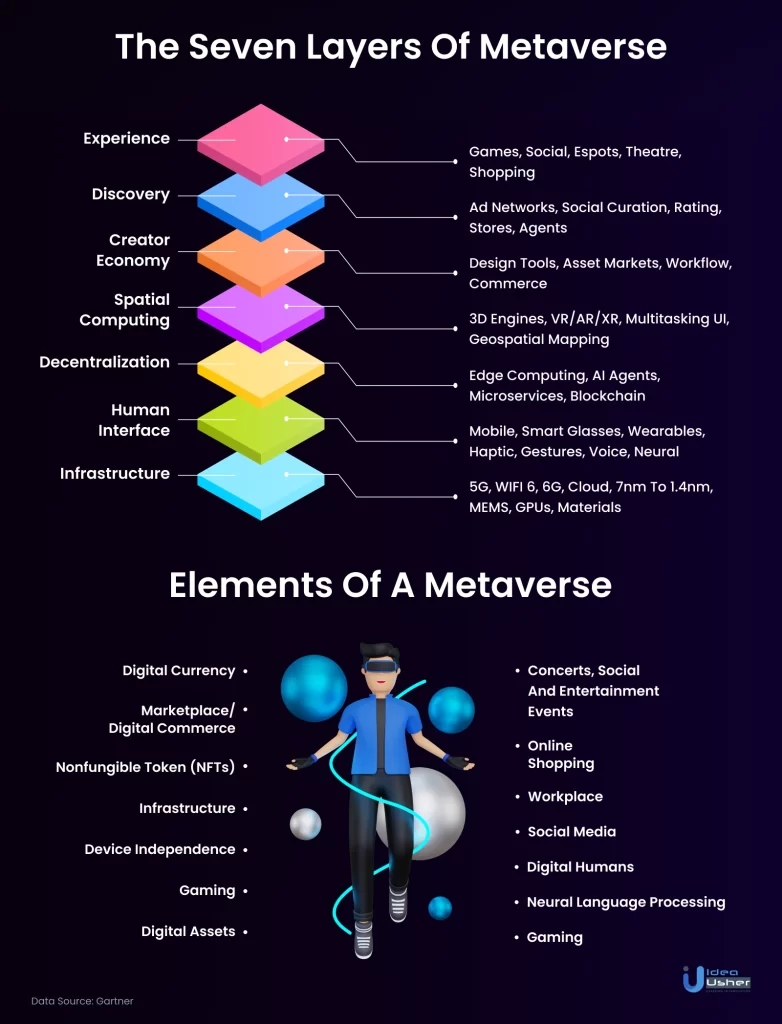
Metaverse market trends to consider for opportunities
1. According to the report by Mckinsey & Company,
- The market for the global Metaverse was anticipated to be worth USD 40 billion in 2021 and is expected to reach USD 1,607.12 billion by 2030.
- The overall amount invested in the Metaverse in 2022 (USD 120 billion) has already more than doubled that of 2021.
- By 2030, the market will be worth more than USD 5 trillion.
- The e-commerce sector is anticipated to profit the most, with a market effect of between USD 2 trillion and USD 2.6 trillion by 2030, followed by,
- The academic virtual learning market (USD 180 billion to USD 270 billion),
- Advertising (USD 144 billion to USD 206 billion) and
- Gaming (USD 108 billion to USD 125 billion).
2. According to the report by Grand View Research,
- In 2021, it was predicted that the worldwide metaverse market would be worth USD 38.85 billion. From 2022 to 2030, it is anticipated to increase at a compound annual growth rate (CAGR) of 39.4%.
- Key factors driving the Metaverse market growth are:
- Increasing usage of Non-Fungible Tokens (NFTs) to trade digital assets
- Rising demand for virtual assets
- Rapid development of Decentralized Finance (DeFi) applications
- Growing focus on developing metaverse platforms
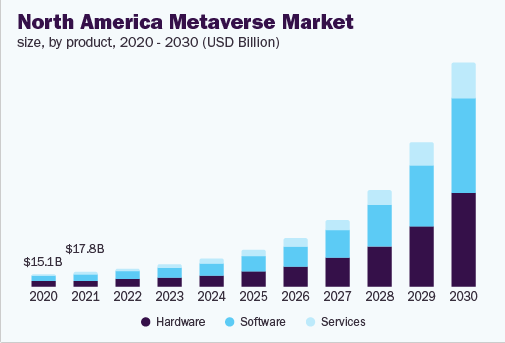
Source: Grand View Research
3. According to the report by Strategic Market Research,
- The size of the worldwide metaverse market was $47.48 billion in 2022 and is expected to increase to $678.80 billion by 2030, with a CAGR of 39.44% from 2022 to 2030.
- At a CAGR of 39.44%, the predicted market size for the Metaverse in 2030 is USD 678.80 billion.
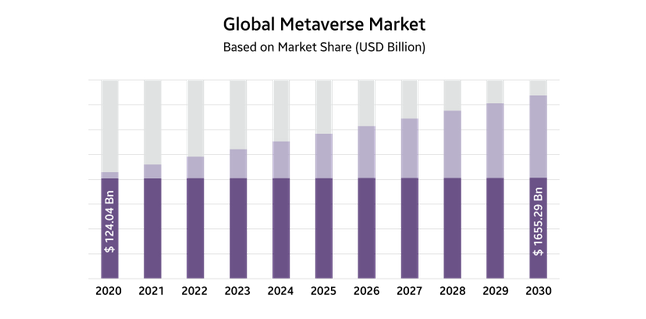
Source: Grand View Research
4. JP Morgan highlights a number of technical problems that Metaverse can address:
- Analytics using open and accessible data.
- Receiving, storing, and using data
- New avatars that are quite lifelike.
- Facilitating standards for digital asset management.
- Easing the load on the user’s equipment.
How will Metaverse evolve further in the future?
Metaverse technology will bring a different level of modernization and comfort by energizing virtual interactions. However, to understand how the Metaverse will change in the future, let’s go a little deeper:
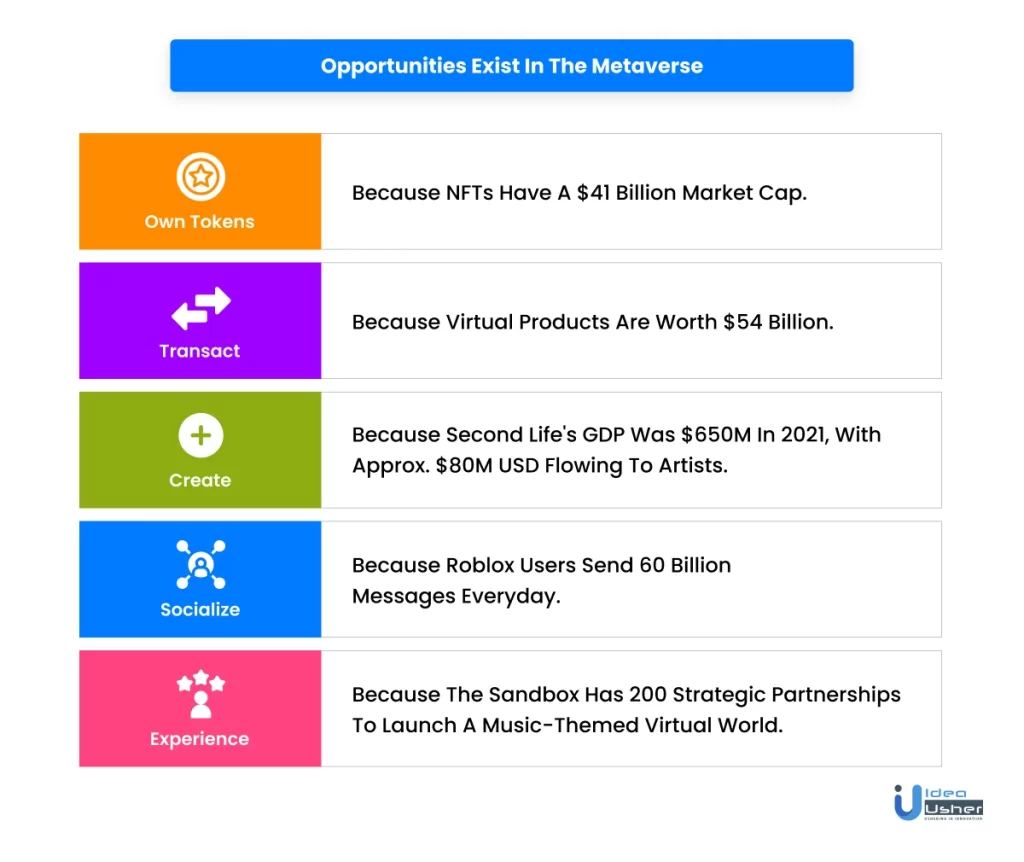
1. Web 3.0
Web 3.0 was designed to enable value-added interactive transactions, unlike the simple transactions of Web 2.0. Currently, access to the virtual world in the Metaverse is only possible through VR headsets and Mo-cap gloves. However, technological advancements will soon remove this restriction.
Voice typing is becoming outdated in the digital era, as voice search is now preferred by 71% of customers. This shift has led to the development of voice assistants, making them ready for the digital age. In the Metaverse, speech exchanges are more natural and effective, leading to the popularity of interactive conversational marketing and commerce among metaverse businesses.
In conclusion, the Metaverse is set to revolutionize the way we interact and transact in the digital world. With advancements in technology, users will have access to an even more immersive and effortless experience. The shift towards voice-based interactions is a testament to this, as it brings a more genuine and intuitive feel to transactions in the virtual world.
2. Interoperability
As a customer-focused strategy, interoperability between Metaverse platforms to connect various virtual worlds will open up new opportunities for corporate growth.
For example, users who wish to order food while utilizing your Metaverse platform must first quit, place their order, and then re-enter. They must repeatedly depart and re-enter in order to track orders till they are delivered. The user may quickly switch from your platform, order food, and then return if compatible Metaverse channels exist.
3. Persistence
How well the Metaverse reflects and responds to changes occurring in real time may be used to gauge its effectiveness.
To give an example, imagine that various users are taking part in a single Metaverse at various times and from various locations. It makes no difference whether a person joins or leaves the group. The activities of the other participants can go on uninterrupted. However, for a Metaverse platform to be permanent, it has to use services and applications that can be moved around, expanded upon, and dynamically configured.
4. Digital twins
Digital identities often called digital twins, are now possible for every individual, object, and business in the Metaverse. Anyone may create a digital twin of the actual world that can be true, anonymous, or fictitious.
Businesses may create an organization twin in the virtual world with a setting that is identical to their actual working environment. Additionally, they can build digital twins of their resources and assets. It’s the same as having staff in the Metaverse who can communicate with people exactly as they would have in person. This can significantly minimize mistakes and redos while boosting productivity.
5. Privacy and security
When it comes to safeguarding user data in a decentralized digital environment, security is crucial. Your Metaverse platform may be vulnerable to assaults or malicious activity through several access points. The deception that afflicts the Metaverse platform may be reduced by strict enforcement mechanisms, governance, and data control, along with some guidelines for how a Metaverse platform might develop over time.
Some recent developments in the Metaverse:
It is critical to comprehend how everything functions and what initiatives outside of Decentraland and Sandbox deserve consideration. Here are some of the innovations in Metaverse:
1. Bit.Country

Bit.Country is built on the Metaverse network and is a great substitute for Decentraland and Sandbox. The users may create a miniature country with its rules and laws, cryptocurrencies, and user incentives. The platform contains an economy as well as other useful functions.
At present, almost every nation now uses the Polkadot blockchain. Users may have a direct impact on how the virtual world appears. In Bit.Country, each block that represents a place has 100 pieces, and together they make up the locations. These tradeable segments may be used to store assets, NFTs, or launch events. People can create their own cryptocurrencies or transfer any coins from the market if required for the ecosystem.
2. Moonscape

People may use this platform to make money using NFTs and DeFi components. In the game, the action happens on the moon. The participants’ tasks include building bases, scouting out potential locations, and arming their forces.
The blockchain network that the game is built on has great levels of intricacy in every aspect. The main token for this project first surfaced in early 2022, making it one of the newest ones. As of now, exchanges have not yet listed the coin.
3. PlayMining

Digital Entertainment Asset developed the blockchain-based PlayMining platform. The goal of the project is to reinvent online gaming and alter people’s perceptions of this kind of amusement and profit. The idea of the game is to get rewards by acquiring rather than through spending. The project uses blockchain, NFT, and cryptocurrency and has its own economy. The users are rewarded for their in-game participation using these resources.
4. Star Atlas
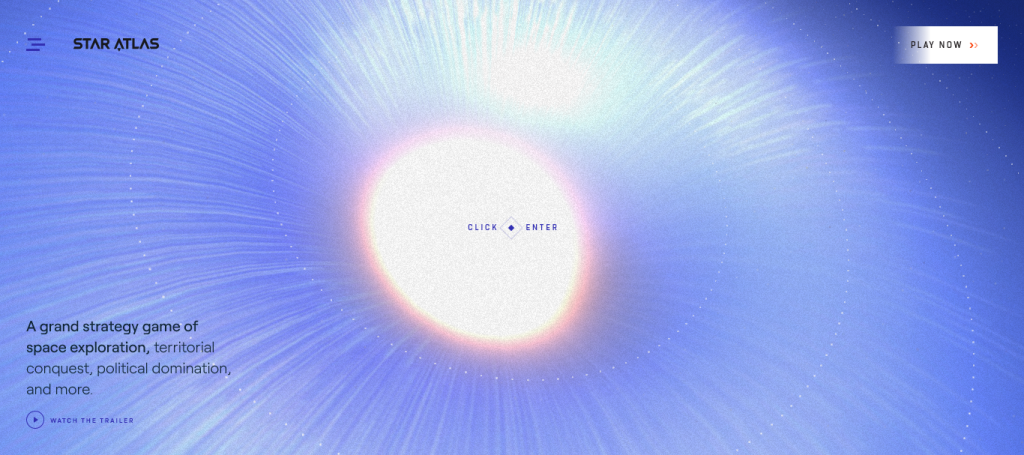
This is a Solana-based project that employs DeFi technology and powerful real-time visuals. The story revolves around creating a spaceship that would enable exploration of the Metaverse’sMetaverse’s locales. The primary distinction between this game and others is the use of NFTs for starship design and purchase.
We might conclude from the foregoing that whether we like it or not, meta-universes, virtual worlds, and a new reality are what the future has in store for us. The active blending of technology and life has improved many facets of existence. The tendency will only get stronger over the coming years, so it might be time to start thinking about purchasing a plot in Sandbox, learn about NFT and blockchain, and choose the most practical virtual environment for both daily living and professional and commercial endeavors.
Jump right into the trends of Metaverse with Idea Usher!
You can kick start your business in Metaverse with Idea Usher as our services guarantee satisfying results at their maximum potential. In close collaboration with you, our experts will design and develop a user-friendly platform that simplifies the engagement with the offerings for you and your client.
We make it simple for your clients to indulge with your product and services and keep them coming back for more. We dedicate ourselves to providing you with aesthetic, user-friendly, easy-to-navigate applications. You will be able to improve client retention, enhance revenue, and advance your engagement with our solutions and technologies. To discuss how we can contribute to the growth of your business, get in touch with us now.
Build Better Solutions With Idea Usher
Professionals
Projects
Contact Idea Usher at [email protected]
Or reach out at: (+1)732 962 4560, (+91)859 140 7140
FAQ
Q. What is the defining future of the Metaverse?
A. The Metaverse is creating a persistent and interconnected virtual environment where everything has the potential to mimic reality – is promising. In Metaverse, users can interact with other users irrespective of their location, trade assets, conduct immersive engagement, etc.
Q. How may the Metaverse alter our experience?
A. The Metaverse’s virtual worlds, according to their proponents, have the potential to boost cooperation, accelerate training, decrease the need for physical office space, and generally make work a more enjoyable experience.
Q. What businesses will benefit from the metaverse in 2023?
A. Here is some business that seems to benefit from the Metaverse:
- Digital marketing.
- Social media.
- Gaming.
- E-commerce.
- Fitness and sports.
- Education.
- Entertainment, such as TV shows and movies.
- NFTs, digital art, virtual fashion, etc.
Q. What is the benefit of purchasing land in the Metaverse?
A. In the virtual world, once you make a purchase, you completely own the real estate there! This is because NFTs have given us access to the power of digital ownership. You are free to use the property for whatever you wish as the owner. This implies that you may personalize it as you choose, conduct online gatherings, or rent it for extra income.
Rebecca is a multi-disciplinary professional, proficient in the fields of engineering, literature, and art, through which she articulates her thoughts and ideas. Her intellectual curiosity is captivated by the realms of psychology, technology, and mythology, as she strives to unveil the boundless potential for knowledge acquisition. Her unwavering dedication lies in facilitating readers' access to her extensive repertoire of information, ensuring the utmost ease and simplicity in their quest for enlightenment.
Hire the best developers
100% developer skill guarantee or your money back. Trusted by 500+ brands

Contact Us
- SCF 98, Phase 11, Sector-67 Mohali, 160062
- 651 B Broad St, Middletown, 19709, county New Castle Delaware, USA
- [email protected]
- (+1) 628 432 4305
HR contact details
Follow us on

Idea Usher is a pioneering IT company with a definite set of services and solutions. We aim at providing impeccable services to our clients and establishing a reliable relationship.
Our Partners
Contact Us
- SCF 98, Phase 11, Sector-67 Mohali, 160062
- 651 B Broad St, Middletown, 19709, county New Castle Delaware, USA
Follow us on

Idea Usher is a pioneering IT company with a definite set of services and solutions. We aim at providing impeccable services to our clients and establishing a reliable relationship.







Rebecca Lal